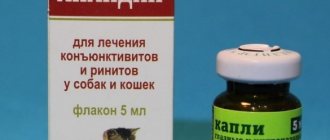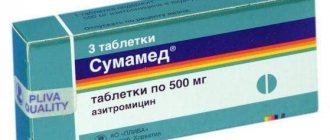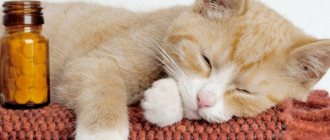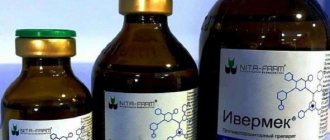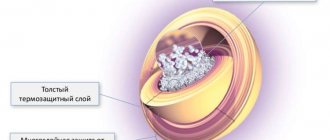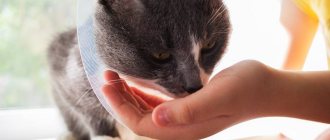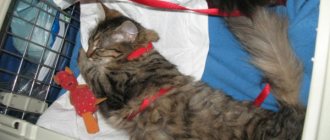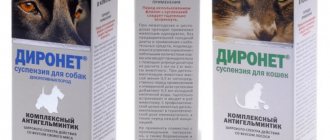Pets, like people, are susceptible to viral diseases. To fight viruses and maintain the animal’s immunity, veterinarians prescribe interferon-based drugs.
Experts believe that Cycloferon is better suited for cats than other medications. However, it is necessary to establish the correct dosage and ensure that there are no contraindications.
Side effects
During treatment, side effects are rare. They are weakly expressed:
- tablets and solution for injection - short-lived weakness, diarrhea, nausea;
- liniment - a short-term burning sensation at the site of application of the medicinal composition, redness of the skin.
Most often, unpleasant symptoms appear in those dogs whose body does not tolerate any substance that is part of Cycloferon. A similar thing is observed with an overdose. This condition passes quite quickly.
But if the dog remains weak and lethargic for more than a day, then it is better to consult a doctor. The veterinarian will decide whether to discontinue treatment with Cycloferon.
Price and analogues
The cost of Cycloferon is quite high. Tablets have the following average price: 10 pcs. – 180-210 rub., 20 pcs. – 350-410 rub., 50 pcs. – 800-900 rub. 5 ampoules per package cost from 350 to 400 rubles. The price of the ointment also depends on the volume of the drug: 5 ml – 120-150 rubles, 30 ml – 400-450 rubles.
There are other drugs for cats that have a similar effect to cycloferon, but they are not its complete analogues:
- Roncoleukin is a very powerful immunostimulant in the form of a solution. Used for diseases caused by fungi, viruses, bacteria. Administered intravenously.
- Fosprenil - used to treat viral diseases. The drug is available in the form of a solution, stimulates the immune system, and increases the body's resistance to infection. Fosprenil is injected subcutaneously, into a muscle, into a vein, and sometimes it is taken orally.
- Neoferon - available in tablets and solution. It has a beneficial effect on the growth of intestinal microflora, relieves inflammation, and stimulates the cat’s immune system.
- Kinoron is a white powder. It is dissolved in distilled water or saline and injected subcutaneously or into the muscle. Kinoron stimulates the immune system and increases the body's resistance to viruses.
- Gamaprene – designed to speed up the recovery of cats. Available in the form of a yellowish transparent liquid. The product is administered to animals orally.
- Gala-vet is available in powder form, which is diluted in water for injection and injected into the muscle. The drug stimulates the immune system and increases the activity of leukocytes.
It is better to consult a veterinarian before use. He will assess the animal’s condition and prescribe a suitable treatment regimen.
About the drug
"Cycloferon" in injections is considered a medicinal product that has a large number of different healing properties. It is used as an immunoregulatory, antimicrobial, radioprotective, and antitumor drug. In the human body, this remedy can linger for a maximum of seventy-two hours. A positive property of “Cycloferon” in ampoules is the fact that it can be prescribed to adults and children for the treatment of viral hepatitis, influenza, ARVI, meningitis, AIDS, etc. This drug improves immunity in people suffering from cancer, dermatology, venereal, gynecological and somatic pathology.
In recent years, more and more scientists have been paying attention to this medical product, or rather its effect on the human body. For example, in the centers for the prevention and control of such diseases as AIDS, special treatment regimens using Cycloferon were developed.
Scientists have even begun to think about making a special form of this drug that will help protect two sexual partners from HIV infection.
Quite often this remedy is used in the treatment of children. In addition to the treatment of ARVI, hepatitis and HIV infection, this drug can also fight such ailments as herpes, toxoplasmosis, otolaryngological diseases, bronchial asthma, intestinal diseases, and autoimmune diseases in children. This remedy can be safely given to children as a preventative medicine that will protect the baby from a large number of various diseases.
Composition of tablets
If you are afraid to give injections yourself, ask your doctor to prescribe Cycloferon in tablet form for your cat. This is the same drug that fights viruses in the animal’s body. Externally, these are round, convex yellow tablets.
Dosage
Be sure to check with your veterinarian regarding the dosage of tablets for pets. Since here everything is also calculated taking into account the weight of the animal. In addition, the dosage depends on what disease the animal has. But in general, cats are given half the tablets once a day. The course of treatment will be 7-10 days.
The main substance in the drug is meglumine acridone acetate. It is this that forces the patient’s body to put up a kind of block from the effects of infections, viruses, etc. As additional substances, the composition contains elements such as povid, hypromellose, polysrbate.
Features of the use of Cycloferon
A popular domestically produced antiviral agent. It was registered in 1995. Stimulates resistance to various infectious agents. The main active component is an element that enhances the production of interferon in the body. A specific feature of this medication is its wide range of pharmacological effects.
The medicine in tablets and solutions is prescribed for diagnosing the following diseases in pets:
- plague;
- hepatitis;
- enteritis;
- papillomatosis;
- chlamydia;
- laryngotracheitis;
- calcivirosis;
- acute respiratory infections;
- rhinochlameids;
- flu.
Calcivirus in cats
The ointment is prescribed as a wound-healing and anti-inflammatory agent after surgery, during the formation of neoplasms, fungal infections of the skin and for the treatment of demodicosis.
Interferon ointment is a powerful anti-inflammatory agent
Composition of Cycloferon
The main active component is acridone acetic acid. Methylcellulose and calcium stearate were used as additional additives.
This drug contains substances that can neutralize many different types of viruses.
Table 1. Composition of Cycloferon
| Element | Properties |
| Acridoneacetic acid | Low molecular weight interferon inducer. The organic compound has anti-inflammatory, immunostimulating and antiviral effects. It is the main ingredient in the production of Cycloferon, Camedon and Neovir. |
| Calcium stearate | A compound of stearic acid and calcium salt. It provokes the acceleration of certain chemical reactions and improves the interaction of elements during the process of mixing them. It also helps create a uniform texture when creating cream-like, gel-like and solid forms of drugs. |
| Methylcellulose | A food additive consisting of cellulose ether and methanol. This white powder is used to produce tablets. |
| Povidone | A substance that actively binds together toxins formed in the body and penetrating from outside. It also promotes their exit through the intestines. |
| Hypromellosis | An auxiliary element in the creation of solid granular forms. |
| Methacrylic acid | This organic compound is a building material used for the synthesis of esters. |
| Ethyl acrylate copolymer | Binding material. |
| Propylene glycol | It is used as a solvent in the production of solutions and ointments. |
| Polysorbate 80 | An emulsifier that helps stabilize immiscible liquids. |
Properties of the drug
This remedy has anti-inflammatory, antitumor and antiproliferative effects.
After its administration, the following processes are launched in the animal’s body:
- Interferons appear in large quantities in the tissues of the spleen, liver and lungs.
- Granulocyte production begins.
- Stem cells in the bone marrow are activated.
- The immune status is corrected.
- Exchange processes are stabilized.
- The body stimulates its own resources to fight the virus.
In addition, the drug promotes rapid regeneration of damaged tissues.
"Cycloferon" stimulates the production of immune granulocytes
Properties and pharmacological action of the drug
The main effect of cycloferon is to stimulate the production of interferon in the body. The medicine relieves inflammation well and improves the animal’s well-being. Cycloferon stimulates the animal’s immune system and normalizes metabolism.
The drug is used as an immunomodulatory, antiviral agent
- calcivirosis;
- acute respiratory infections, including influenza, laryngotracheitis, rhinitis, etc.;
- papillomatosis;
- chlamydia;
- panleukopenia (feline distemper);
- viral diseases of the digestive system (hepatitis, enteritis, etc.).
Along with the antiviral, the drug has an anti-inflammatory effect, inhibits the development of tumors by suppressing the growth of atypical cells, and promotes the restoration of damaged tissues.
When ingested, it has the following effects:
- provokes the production of interferon in the tonsils, liver, spleen, and intestines;
- triggers the production of granulocytes - white blood cells that block inflammation;
- increases the rate of stem cell maturation;
- eliminates disorders in the immune system and activates the body's resources;
- improves metabolism and stops the growth of malignant cells.
In what cases is the drug prescribed to cats?
The basis for treating animals with Cycloferon are identified viral enteritis and hepatitis, carnivore distemper, laryngotracheitis, manifestations of influenza and acute respiratory infections. This medicine is also prescribed for cats if rhinotracheitis, panleukopenia, calcivirosis, and chlamydia are detected in the animal.
The ointment is recommended in cases of injury to the animal or after surgical operations in cats. It helps stop inflammatory processes and has a regenerating effect on the cat’s body. It is also used in the treatment of demodicosis, the occurrence of fungus and the appearance of neoplasms.
Cycloferon for cats interacts well with other symptomatic medications. When used with interferon or antibiotics, this drug can significantly enhance their effect.
Cycloferon can be administered subcutaneously or intramuscularly to cats. If the pet has an acute phase of the disease, the cat is prescribed to inject Cycloferon intravenously, it is combined with serums, globulins and interferon.
For cats, the dosage of Cycloferon varies depending on the weight of the pet:
- 0.80 ml of solution is taken per 1 kg of weight;
- for 1-2 kg - 0.40 ml;
- for 2-5 kg - 0.20 ml;
- for 6-12 kg - 0.15 ml;
- for 13-25 kg - 0.12 ml;
- 26-40 kg - 0.10 ml;
- more than 40 kg - 0.08 ml.
Before using the medicine, you must carefully read the instructions, paying attention to how the drug should be used for kittens, as well as how much Cycloferon tablet contains the active substance. Cycloferon may have side effects
It happens that the animal’s body temperature rises, and with a significant concentration of harmful viruses in the blood, purple fluorescence may appear in the urine
Cycloferon may have side effects. It happens that the animal’s body temperature rises, and with a significant concentration of harmful viruses in the blood, purple fluorescence may appear in the urine.
average cost
The drug cannot be classified as cheap. Tablets in packs of 10 or 20 pcs. will cost 180-210 rubles. or 350-410 rub. respectively. The price of 5 ampoules in pharmacies will be 360-420 rubles. Ointment in a volume of 30 ml can be purchased for 390-440 rubles. The final cost depends on the pricing policy of pharmacies and the region of purchase.
Owners of cats for which this drug was used recommend simultaneously purchasing a vitamin complex and a product to restore intestinal flora.
Sincerely, Pelageya Egorovna
The benefits of injections
What else can you learn from the instructions for use of Cycloferon for injection?
What does the remedy help adults with? This drug, administered in the form of injections, is of great help in the presence of the following pathologies:
- Against the background of HIV infection at the stage preceding the development of a secondary disease.
- For acute and chronic manifestations of cytomegalovirus and herpesvirus infections.
- In case of infection with chlamydia.
- Damage to liver cells in the presence of viral hepatitis.
- For autoimmune connective tissue diseases that are systemic in nature (against the background of scleroderma, lupus erythematosus, rheumatic pathologies of various etiologies).
- When infections occur that are characterized by the predominant localization of infectious agents in the nervous system (that is, neuroinfections).
- Against the background of degeneration or dystrophy of the joints.
Pathological causes
One of the reasons why urine appears purple is most often called “purple bag syndrome,” which refers to pathologies of the body. This disease is quite serious and can cause concern for both the patient and the doctor.
Tryptophan, a special amino acid that enters the body with food, is converted into a biogenic amine - serotonin. The excess settles in the intestines, after which indole is formed. It is produced from the processing of amino acids by bacteria contained in the intestinal microflora. Indole penetrates the liver along with acids, forming a safe indican.
With all the waste, indican can enter the kidneys from the liver through the circulatory system. If the patient has any urinary tract infections, the bacteria that separate indican and sulfuric acid convert it into indoxyl. Once in an alkaline environment, it is processed by microflora into red and blue substances. A mixture of these colors gives blue or sometimes purple color to urine.
Thus, if there is an infection in the genitourinary system, and alkali in the urine, purple sac syndrome may occur when eating foods containing tryptophan. Such products include nuts, black and red caviar, bread, cheese, and sunflower seeds.
One of the reasons that cannot be associated with disorders in the body is taking medications. Antibacterial agents can color urine in different colors; in rare cases, a blue or purple color appears. Using diagnostic drugs may also give a purple hue to fluids leaving the body. As a rule, when drugs are introduced into the body, the color of urine normalizes.
One such drug is Cycloferon, an immunomodulatory and antiviral drug that turns urine purple. This is a side effect of the drug, which is indicated by the manufacturer in the instructions and has no connection with pathology.
We invite you to read: Cat Bayun - instructions for use for cats
Doctors prescribe Cycloferon for the prevention of various viral diseases and treatment of their acute stages. If taking this drug is the reason for changes in the color of urine, then there is no cause for concern. As soon as the remaining medication is removed from the body, the color of the urine will return to its previous values.
Foods, like medications, can color urine. If there are some problems with the metabolism and processing of tryptophan, then foods that contain high amounts of it can turn the urine purple. These include various types of cheeses, almonds, legumes, beets, different types of fish caviar, some types of fish meat.
If such problems arise, you should consult a specialist to treat disorders of the body. It is also important to avoid foods containing tryptophan in large quantities during the treatment period.
Cycloferon tablets instructions for use
It is very important to use it in a course and carefully monitor the regularity of use. The description on the package states that in case of emergency the dose of tablets should be increased
Ointment
Cycloferon is produced as an ointment and contains a large amount of active substance and is sold in 50 ml tubes. It acts primarily against many strains of bacteria, activating cellular immunity. It can be prescribed for various diseases of the genital organs in gynecology, both in men and women, in the treatment of warts in combination with tablets or injections. It is necessary to strictly follow the instructions indicated on the packaging. No negative effects have been proven.
For children
Cycloferon can be used by a child in the form of syrup or solution from 4 years of age. They are also pierced intravenously and in some cases intramuscularly, depending on the type of treatment.
Effective for:
- 1. HIV infections.
- 2. For the prevention of influenza and other infectious diseases.
- 3. Herpes.
As a rule, the general course of treatment in children is 10-12 doses per month. Children's dosage is minimal. More accurate information can be found on Wikipedia. You can use an inhalation nebulizer with an applicator. The drug must be stored out of the reach of children.
During pregnancy
Cycloferon should not be used during pregnancy, especially in the early stages, during lactation. It is possible for pregnant women to replace similar remedies in homeopathy in case of urgent need. The mechanism of action is similar.
In veterinary medicine for cats
For cats and cats, as well as dogs, cycloferon is used to cure the animal from influenza, chlamydia and distemper. In the abstract, 0.3 ppm is usually used intramuscularly for 10 days before meals. May cause fever. Depending on the severity of the condition, the course is extended. The product will help cope with animal diseases.
What can be replaced
Cycloferon has no analogues identical in composition.
In case of urgent need for replacement, when individual intolerance to the components is observed, the following medications can be used:
- Azoxyvet. The solution is used for infections.
- Interferon. An antiviral agent that simultaneously enhances immunity.
- Gamaprene. The injections are used to treat respiratory viruses.
- Glycopene. Sold in tablet form. Effective against various viral infections.
How to inject Cycloferon
The solution is administered intravenously (into the cubital vein) or intramuscularly (into the gluteus maximus muscle). The frequency of administration is 1 time per day, every other day. The treatment regimen is determined by the underlying disease. For herpes and cytomegalovirus infections, give 10 injections of 2 ampoules (250 mg). For infectious diseases of the brain, Cycloferon is injected in 2 ampoules (250 mg). The course of treatment is 24 days (12 injections every other day).
In gynecology (for chlamydia), 10 injections of 2 ampoules are given. After 10-14 days, the course of treatment is repeated. For acute inflammation of the liver (hepatitis), injections are given in a dosage of 500 mg, 10 injections in total. For chronic hepatitis, additional maintenance therapy is carried out (3 months, 3 injections per week).
For HIV infection, a basic treatment regimen is used, which includes 10 injections every other day at a dosage of 500 mg. Then they switch to a maintenance dose (injections once every 3 days for 2.5 months). In case of immunodeficiency due to existing diseases, Cycloferon is administered intramuscularly, 1 ampoule. The course of treatment consists of 10 injections. Repeated therapy is carried out after 6-12 months.
For rheumatic and systemic pathologies, the correctly prescribed dose is 250 mg/day. A total of 4 courses of 5 injections (20 injections) are carried out. There should be a break of 10-14 days between them. If the patient has osteoarthritis of the joints, Cycloferon is administered every other day in two courses of 5 injections. The daily dosage for influenza for children is 6-10 mg/kg. It is better to use tablets instead of a solution. For adults with influenza and ARVI, Cycloferon is administered every other day. The dosage is determined by the doctor depending on the severity of the condition.
The drug Cycloferon for children is best administered intramuscularly. You should first check the condition of the solution, expiration date and integrity of the ampoules. Hands and injection site are treated with alcohol. After drawing the medicinal solution, you need to release the air from the syringe. The injection is given in the upper outer quadrant of the buttock. The needle should be at an angle of 90º to the surface of the skin.
Injections for immunity Cycloferon can be injected into the cubital vein.
The injection is made into the cubital vein. The needle is inserted almost parallel to the skin with the cut facing upward. Then it is advanced along the course of the vessel. After performing an intravenous injection, the arm is bent at the elbow joint.
Is the injection sick or not?
With the correct technique, the Cycloferon injection is not painful.
What do you think are the most important factors when choosing a medical facility? Poll Options are limited because JavaScript is disabled in your browser.
The injection solution should not be injected into children and adults daily.
This is the standard treatment regimen.
Can I take the drug?
The solution is used only parenterally (bypassing the gastrointestinal tract). It cannot be taken orally. You can take Cycloferon tablets.
They are taken half an hour before meals with water. The dosage depends on the age of the person. Adults and children over 12 years of age are recommended to take 3-4 tablets per day at once.
Composition and release form
The drug has found widespread use in veterinary medicine. Its active component is acridoneacetic acid, and it is supplemented by such excipients as methylcellulose and calcium stearate. The pharmaceutical product has pronounced antiviral activity and is presented to consumers in the following forms:
- Pills. They have a light yellow color and are packaged in packages of 10, 20 or 50 pieces each.
- Injection solution. Transparent, yellowish liquid, which is sold in ampoules of 2 ml. Consists of the main ingredient and special water for intramuscular injection.
- Liniment. It is an ointment for surface treatment of the dermis, distinguished by its yellow color and specific odor.
It is available in three forms:
- Light yellow round tablets of 10, 20 or 50 pieces per package. One tablet contains 150 mg of meglumine acridone acetate, 23.21 mg of methacrylic acid, 7.93 mg of povidone, 2.73 mg of hypromellose, 0.27 polysorbate 80, 1.79 propylene glycol, 3.07 mg of calcium stearate.
- Solution for intramuscular administration. Available in ampoules, 2 ml each. The package contains 5 ampoules with instructions. The solution is transparent, yellow. Contains 125 mg/1ml meglumine acridone acetate and water for injection.
- Liniment or liquid yellow ointment for external use has a specific odor. Contains 50 mg of meglumine acridone acetate per 1 ml. Excipients: 0.1 mg benzalkonium chloride and propylene glycol. The tube contains 5 or 30 ml of liniment.
Cycloferon for animals is produced in three forms: in tablet form, in the form of liniment, and also in the form of a colorless solution for injection.
The main component of this drug is acridone acetic acid. This is an artificial analogue of a natural substance - an alkaloid from Citrus grandis. It stimulates the production of interferons and activates the bone marrow. Capable of stopping the growth of tumors.
One of the dosage forms of the drug Cycloferon is tablets.
Available in 3 dosage forms:
- Injection solution is the most commonly used. It is administered intramuscularly, is quickly absorbed, remains in the body for about a day, and is excreted mainly by the kidneys.
- Tablets (have a pinkish tint). When taken orally, maximum concentration is reached after 2-3 hours, and the half-life is 8 hours. You need to take them once a day, half an hour before meals. Cats and small kittens can be given the drug in tablets, strictly observing the dosage - if there is no vomiting. Although injections into the withers give a faster effect.
- Liniment is yellow. Used topically to treat viral infections on the skin, including fungal infections. Used to treat gum inflammation of a viral or fungal nature.
The mammalian body has an antiviral defense system. The main participants in this defense are interferons - natural proteins that are produced as a response to infection. They help the body cope with the virus as quickly as possible.
If the protective barrier is weakened, the number of interferons produced decreases, and the immune response leaves much to be desired. To support the body, scientists have developed medications based on artificial interferons.
"Cycloferon" is an effective drug for the treatment of viral infections
Interferon is a healing protein molecule that provides antiviral protection. Its inherent nonspecific activity helps to influence all infectious agents in general, not only a specific pathogen.
Interferons are universal guardians that act long before the awakening of other parts of the immune system.
The body produces a protective protein after the penetration of pathogenic bacteria, viruses and cancer cells. Man-made interferon inducers are capable of artificially stimulating their production.
The principle of action of interferons
In addition to directly affecting infected cells, these molecules perform a number of important functions:
- They excite cellular enzymes that cause disruptions in the production of viral molecules.
- Protect the body from the formation of malignant and benign formations.
- Controls inflammatory reactions.
- They initiate the cleavage of RNA in cells - acids responsible for the movement of infectious agents to other structural units.
- Promote the production of p53 protein, which causes the destruction of damaged cells.
Interferons suppress the proliferation of pathogenic bacteria
By their nature, interferons are aggressive. They affect both harmful foreign structures and ordinary cells.
According to doctors, when interferons enter the body, the immune system is activated within 4 hours.
The drug is available in 3 forms:
- Injection. A clear liquid that can be administered intravenously or intramuscularly. The package contains 5 ampoules - enough for a standard course of treatment.
- Pills. Sold in cardboard boxes of 10 or 20 pcs. Each pill contains 150 mg of meglumine acridone acetate. Dissolves in the intestines.
- Yellow ointment for external use. Tube volume: 30 ml. Contains 5% of the main active ingredient.
The choice of form depends on the nature of the disease, the severity of its course and the individual tolerance of the drugs to the animal.
How and when is Cycloferon used for cats?
The instructions state that indications for the use of the drug are carnivore distemper, viral enteritis and hepatitis, laryngotracheitis, influenza, and other acute respiratory diseases. Cycloferon is prescribed for rhinotracheitis, panleukopenia, calcivirosis, chlamydia in cats.
The ointment is prescribed in veterinary surgery as an anti-inflammatory and wound-healing agent. It is also used in the treatment of demodicosis, after operations, for fungal infections of the skin of animals, and neoplasms.
The instructions inform you that Cycloferon solution and tablets combine well with other symptomatic drugs. By combining the medicine with interferon or antibiotics, you can enhance and prolong the effect of the latter.
Cycloferon is administered subcutaneously or intramuscularly to pets. In acute periods of illness, it is prescribed intravenously, in combination with serums, globulins, and interferon.
The dosage of the medicine is prescribed depending on the weight of the animals. Thus, cats up to one kilogram are administered 0.80 ml of the drug, two-kilogram pets - 0.4 ml per kilogram. Weight from 2 to 5 kg - 0.20 ml/kg, from 6-12 kg - 0.15 ml/kg, over 12 kg - 0.12 ml/kg.
The drug is used for the spread of viral hepatitis or enteritis, canine distemper, influenza, laryngotracheitis, and respiratory ailments. It is also used for diseases of cats and cats with panleukopenia, chlamydia, rhinotracheitis, and calcivirosis.
The solution of Cycloferon and its tablets are perfectly combined with other symptomatic drugs. By combining the drug with antibiotics, interferon and other similar substances, their effects can be prolonged and greatly enhanced.
For pets, the solution is prescribed intramuscularly or under the skin. In particularly acute cases, it is combined with interferon, globulins, serums and injected directly into a vein.
The dosage of the medicine is carried out in accordance with the pet’s body weight. The dose for kittens and adult animals is selected according to the following scheme.
When administering an injection (using a solution) or treating an animal with tablets, the maximum content of the substance in the blood is observed only after 3-4 hours. Its removal from the body occurs within 5 hours.
The use of Cycloferon in doses permitted by the instructions does not allow it to be deposited in the body. The drug leaves the body naturally (through the kidneys).
The gel (ointment) is known as a wound healing and anti-inflammatory agent. Veterinarians recommend using it in surgery; it is used in postoperative treatment, in the treatment of demodicosis, and in the event of the appearance of tumors and skin lesions of any type of fungus.
When to use this medicine
The drug is recommended for the treatment of cats diagnosed with:
- flu;
- enteritis;
- feline distemper;
- acute respiratory diseases.
Solutions are prescribed for inclusion in complex therapy of secondary immunodeficiencies that have developed against the background of acute and chronic bacterial and fungal infections, rheumatic, degenerative pathologies (arthritis, lupus, osteoarthritis, etc.).
The indication for injections is viral hepatitis. Liniment is used for herpes and chronic periodontitis. The external remedy is also prescribed as an anti-inflammatory and wound-healing medicine.
Flu in cats develops at lightning speed - if treatment with antiviral drugs is not started, the animal can die within a couple of days
Cycloferon is allowed to be combined with any drugs. But it is worth considering that the medicine can enhance the effect and increase the risk of side effects of drugs with interferon and nucleoside analogues, so it is recommended to slightly reduce their dosage during complex therapy.
Closed ampoules are stored for no more than 5 years at room temperature (up to 25°C). Opened but not completely used items are immediately thrown away. The tablets have a shelf life of 2 years. They also don't need to be refrigerated.
The ointment is stored at a temperature of 15-20°C. At lower temperatures, it will change consistency and may lose its healing properties. The medicine should be hidden from children and animals. Do not leave in the sun.
Indications in veterinary medicine
Most often, veterinarians prescribe Cycloferon for viral infections in dogs. The main indications are:
- distemper (distemper of carnivorous animals);
- coronavirus and parvovirus enteritis;
- viral papillomatosis (most often papillomas appear in the mouth area);
- laryngotracheitis (inflammation of the larynx and trachea);
- conjunctivitis (inflammation of the mucous membrane of the eyes);
- hepatitis of various origins;
- colds.
After castration
The drug is prescribed after surgical operations (including during castration) as a means that can fight inflammation and improve the condition of the dog’s immune system.
For tumors
Due to its immunomodulatory properties, Cycloferon is indicated for malignant tumors. The drug inhibits the growth of tumors.
But it is impossible to cure cancer with this remedy. The medicine is used in conjunction with chemotherapy.
During heat
If the dog gets sick during estrus, then Cycloferon should be used only as prescribed by a doctor and under his supervision.
Pregnant, lactating and puppies
It is not recommended to use Cycloferon in the treatment of pregnant and lactating dogs. In rare cases, the drug can be prescribed to puppies, but treatment should be under the supervision of a veterinarian. The doctor selects the individual dosage, duration of therapy and dosage form of the medication.
What's in Cycloferon?
The main active component of this drug is acridoneacetic acid, and the excipients are methylcellulose and calcium stearate.
Cycloferon for cats is produced in three forms: in tablet form (brown pills), in the form of liniment (yellow ointment), and also in the form of a colorless solution for injection (2 ml ampoules). It is used as an immunomodulatory and antiviral agent. Cycloferon is a high-molecular inducer of the formation of endogenous interferon.
Once in the cat’s blood, the components of the drug become biologically active. Cycloferon has antitumor and antiproliferative properties. Cycloferon for cats helps cope with the anti-inflammatory effect. After the injection, the number of interferons in tissues with lymphoid elements (spleen, lungs, liver) increases noticeably.
This remedy for cats also activates bone marrow stem cells. Granulocytes begin to be rapidly produced.
Under the influence of the medicine, the status of the immune system is noticeably corrected, which has received a powerful incentive to mobilize internal resources to fight foreign harmful bacteria. Cycloferon has a beneficial effect on normalizing metabolism.
It is found on pharmacy shelves in the form of an ointment and is intended for external use. Cycloferon promotes the regeneration of mucous membranes and damaged upper tissues. It is also possible to use Cycloferon for viral diseases of pets.
The peak concentration of Cycloferon in the cat’s blood is observed two to four hours after the injection or taking the tablet. A significant part of the drug is excreted from the body in four to five hours along with urine; if the dosage is observed, it practically does not accumulate in the body. High biological activity is well complemented by its low toxicity.
In what cases is the drug prescribed to cats?
The basis for treating animals with Cycloferon are identified viral enteritis and hepatitis, carnivore distemper, laryngotracheitis, manifestations of influenza and acute respiratory infections. This medicine is also prescribed for cats if rhinotracheitis, panleukopenia, calcivirosis, and chlamydia are detected in the animal.
The ointment is recommended in cases of injury to the animal or after surgical operations in cats. It helps stop inflammatory processes and has a regenerating effect on the cat’s body. It is also used in the treatment of demodicosis, the occurrence of fungus and the appearance of neoplasms.
Cycloferon for cats interacts well with other symptomatic medications
. When used with interferon or antibiotics, this drug can significantly enhance their effect.
Cycloferon can be administered subcutaneously or intramuscularly to cats. If the pet has an acute phase of the disease, the cat is prescribed to inject Cycloferon intravenously, it is combined with serums, globulins and interferon.
For cats, the dosage of Cycloferon varies, depending on the weight of the pet.
:
- 0.80 ml of solution is taken per 1 kg of weight;
- for 1-2 kg - 0.40 ml;
- for 2-5 kg - 0.20 ml;
- for 6-12 kg - 0.15 ml;
- for 13-25 kg - 0.12 ml;
- 26-40 kg - 0.10 ml;
- more than 40 kg - 0.08 ml.
Before using the medicine, you must carefully read the instructions, paying attention to how the drug should be used for kittens, as well as how much Cycloferon tablet contains the active substance. Cycloferon may have side effects
It happens that the animal’s body temperature rises, and with a significant concentration of harmful viruses in the blood, purple fluorescence may appear in the urine
Cycloferon may have side effects. It happens that the animal’s body temperature rises, and with a significant concentration of harmful viruses in the blood, purple fluorescence may appear in the urine.
The drug is used for the spread of viral hepatitis or enteritis, canine distemper, influenza, laryngotracheitis, and respiratory ailments. It is also used for diseases of cats and cats with panleukopenia, chlamydia, rhinotracheitis, and calcivirosis.
The solution of Cycloferon and its tablets are perfectly combined with other symptomatic drugs. By combining the drug with antibiotics, interferon and other similar substances, their effects can be prolonged and greatly enhanced.
For pets, the solution is prescribed intramuscularly or under the skin. In particularly acute cases, it is combined with interferon, globulins, serums and injected directly into a vein.
The dosage of the medicine is carried out in accordance with the pet’s body weight. The dose for kittens and adult animals is selected according to the following scheme.
When administering an injection (using a solution) or treating an animal with tablets, the maximum content of the substance in the blood is observed only after 3-4 hours. Its removal from the body occurs within 5 hours.
The use of Cycloferon in doses permitted by the instructions does not allow it to be deposited in the body. The drug leaves the body naturally (through the kidneys).
The gel (ointment) is known as a wound healing and anti-inflammatory agent. Veterinarians recommend using it in surgery; it is used in postoperative treatment, in the treatment of demodicosis, and in the event of the appearance of tumors and skin lesions of any type of fungus.
Pets are not immune to viral diseases. One of the most effective and common drugs that help fight infections is the drug Cycloferon. Cycloferon is used for cats to the same extent as for people. This medication is used to counter viral attacks.
What contagious infections can animals get?
Alas, four-legged friends often suffer from illness. Their illnesses are somewhat similar to those of humans, only the pet cannot tell the owner what exactly is hurting him. You have to watch the kitty and think that it is not without reason that the animal is lethargic, moves little, has dull and disheveled fur, discharge from the nose, and has no appetite.
What is the first thing to do when such symptoms appear?
It is necessary to measure Murka's temperature rectally: if it is above 39 degrees, then there is no point in guessing, but it is better to quickly contact a veterinary clinic for accurate diagnosis and treatment.
Imagine that you are delaying a visit to the doctor because of your “no time” or “let’s go tomorrow”, but your furry’s disease progresses, intoxication and dehydration occur. Suddenly the pet is seriously ill and has:
- ARI or flu? After all, the kitty eats poorly or completely refuses to eat, constantly sneezes, breathes heavily, and purulent discharge flows from the nose and eyes;
- cat plague or panleukopenia, and is it a dangerous disease with a high mortality rate? Refusal of food and water characterizes the onset of the disease, then the temperature rises, convulsions appear, vomiting with greenish foam, diarrhea;
- viral enteritis? Suddenly, because of it, the intestinal walls become inflamed so that beneficial substances are not absorbed by the body at all? The animal quickly weakens and may even die without timely help;
- calicivirus, in which the mucous membranes of the nose, tongue, palate, lips become covered with ulcers, and serous fluid leaks from the nose and eyes? As the temperature rises, the animal begins to develop a fever and a deterioration in its general condition;
- papillomatosis or papilloma? This scourge occurs on the skin or mucous membranes in the form of a benign tumor;
- chlamydia ?
It causes inflammation of the respiratory tract in cats; - Did laryngotracheitis occur due to an inflammatory disease of the nasopharynx? If left untreated, it will go lower - into the bronchi, and even worse - into the lungs and, what then?
Instructions for use
This product is available in several forms.
Table 2. Release form of the drug
The kidneys are responsible for removing drugs from the body. When used in the recommended dosage, the active ingredient is not retained in the body. The drug has low toxicity.
The dosage is determined by the weight of the animal.
Table 3. Dosage of Cycloferon
Treatment regimen
When a cat’s body is affected by a virus, immunostimulants are first prescribed. Modulators are introduced later, since drugs in this group improve cellular permeability to viral agents.
Stages of therapy.
Stage 1.
Immunostimulants - "Cycloferon". The drug is most effective in the form of injections. The product must be administered subcutaneously or intramuscularly once every 2 days. If the disease is in an advanced form, an intravenous injection is given according to the following scheme:
- at the rate of 0.5 per 1 kg of weight - 1, 2, 4, 7, 10, 14 days;
- at the rate of 0.2 per 1 kg of weight - 1, 2, 4, 6, 8, 10 days.
The drug can be combined with other immune drugs.
Stage 2.
Hyperimmune serum - "Vitafel". Injected subcutaneously. The dosage is not determined by the body weight of the animal. Depending on the stage of the disease, 2 or 3 injections are given with a break of 12 and 24 hours, respectively.
Stage 3.
Preparations to strengthen the body:
- vitamin and mineral supplements;
- probiotics - “Neoferon”, “Lactobifid” and “Bifidumbacterin”.
These funds are used at the recovery stage.
Stage 4.
Replacement therapy:
- saline solutions;
- 5% and 10% glucose solution;
- B vitamins;
- a nicotinic acid.
These drugs are prescribed if the pet refuses food and water.
Additionally, you can drip Anandin, Polyoxidonium, Maksidin and Derinat to your cat.
Contraindications for use
There are practically no prohibitions on the use of this product. There are only a number of small restrictions:
- hypersensitivity to the active component;
- allergic reactions;
- exhaustion of the body;
- pregnancy;
- cirrhosis of the liver;
- lactation period.
Side effects
Allergies are the main side effect. However, such a reaction is very rare. Sometimes there is an increase in body temperature and purple coloration of the urine.
Directions for use, dosage for cats
Cycloferon is well compatible with drugs for symptomatic therapy. It is administered to cats intramuscularly or subcutaneously.
Injections are made according to the scheme using a regular syringe. In extremely severe cases, intravenous infusions may be required. Tablets are given with food when injections are not possible. The dosage is from 1/5 to 1/4 tablet.
Places to properly administer medications to your cat
Cycloferon ointment is used in veterinary practice to accelerate the healing of wounds and postoperative sutures. The ointment is also prescribed for skin growths, dermatosis and fungal infections. How many times a day you need to apply the drug is determined by a specialist.
The dosage of the medicine is calculated based on the weight of the pet.
Cycloferon is administered by injection per 1 kg of weight in the following volume:
- weight up to 1 kg – 0.8 ml;
- weight from 1 to 2 kg – 0.4 ml;
- weight from 2 to 5 kg – 0.2 ml.
In case of severe condition of the cat and intravenous infusion of the composition, the dose is 0.5 ml of the drug per 1 kg of the pet’s weight. Animals are given injections every other day for 2 weeks. When treating a kitten, the dosage is often calculated individually.
A slight increase in the cat’s temperature during therapy is considered normal due to the body’s increased immune response to the pathogen.
Duration and storage rules
The solution is stored at a temperature no higher than 25 degrees and no lower than 0 degrees (for ointment, the minimum permissible storage temperature is 10 degrees). Tablets and liniment retain their medicinal properties for 2 years, solution in ampoules - 3 years.
The drug is stored in a dark place, protected from pets and small children.
It is recommended to store the tablets out of the reach of children in a cool, dark place.
Symptoms and diagnosis
The herpes virus, when it enters the nose and mouth of an animal, penetrates the cells and causes their death. At the beginning of the inflammatory process, minor foci of necrosis appear, then they grow. By attaching to white blood cells, pathogens enter the bloodstream and spread throughout the body, causing fever and poor health.
Heavy discharge from the eyes and nose is a characteristic feature of rhinotracheitis. Such signs in a pet should not be ignored. The animal also has:
- temperature increase up to 40 C;
- rapid, labored breathing with whistling;
- cough;
- runny nose and sneezing;
- purulent accumulations in the throat;
- poor appetite;
- drooling;
- lethargy;
- white coating on the nose;
- mucous membranes swell;
- difficulty swallowing when eating food and water;
- ulcers all over the body.
The listed symptoms may appear selectively. In adults, rhinotracheitis is much milder, so in most cases only rhinitis is observed.
The disease has degrees: acute, subacute and chronic. The first appears most often. In this case, the cat’s temperature rises strongly in the first 1-2 days, then the animal is overcome by rhinitis and conjunctivitis. Transparent discharge from the mucous membranes is replaced by purulent ones and may even contain blood impurities. If the virus affects the digestive system, diarrhea and vomiting begin. The eyelids stick together due to copious gray pus.
Viral rhinotracheitis is similar in symptoms to many diseases, for example, chlamydia, calicivirus, and reovirus. To confirm the diagnosis, smears are taken from all mucous membranes. Based on them, PCR studies and immunofluorescence analysis are carried out.
Examination of a cat by a specialist makes it possible to identify inflammation of the bronchi, lungs and trachea.
Reviews from pet owners and doctors
Cycloferon is effectively used in the complex therapy of corono-, parva-, and adenovirus infections of dogs and cats. Well tolerated. For 20 years I have not observed a single complication. An adult dog can safely be given up to 250–300 mg per 30 kg. Cats: 25–50 mg per 3–5 kg.
ZooDoc
https://kupluprodammoskva.ru/index.php?topic=44657.0
A two-year-old vaccinated cat lived in our house. But they brought a second kitten, and he had calcivirus, which he infected the older pet with. We were prescribed treatment with several medications: Vitafel (1 dose, 1 day), Suprastin (0.2 ml, 1 day), Cefazolin (1 ml for 6 days), B12 (1 ml, 4 days) and Cycloferon injections (1 ml, course 10 days). The ulcers were smeared with Cycloferon, but in the form of an ointment. All cats recovered without consequences, and after 2 weeks they were already healthy.
krooolcha
https://irecommend.ru/content/vpervye-poznakomilis-s-nim-pri-lecheniikotikov-istoriya-s-khoroshim-kontsom-nemnogo-pro-kalt
I work in a nursery. Our virus spread to adult cats and a little bit to kittens. The disease developed in the same way for everyone: an inflamed eye, runny nose, cough. The treatment regimen for viral infections is the same: antiviral drugs, immunostimulants, complex vitamin and mineral preparations, antibiotics, symptomatic if necessary, and drugs to restore microflora. Cycloferon was chosen as an immunostimulant. Affordable and good drug. Very effective when administered intravenously. They gave it at an approximate rate of 0.2 per kg of weight. They placed them intermittently: only on days 1, 2, 4, 6, 8 and 10 of the course. All cats tolerated the drug well.
Elven Pride
https://elvenpridecats.livejournal.com/79312.html
Cycloferon is a universal drug that, by enhancing immune defense, accelerates the death of viruses. Additionally, it also has an anti-inflammatory effect. It is considered safe for treating cats, as it very rarely causes side effects and has a minimal number of contraindications. For convenience, it is available in three forms - tablets, solutions, ointments. The main thing is to follow all instructions from the instructions for use.
Cycloferon for cats is used quite often in veterinary practice. It allows you to replenish the animal’s interferon deficiency when the body’s natural defenses are weakened due to viral infections.
The substances in the drug activate the immune system, quickly increasing the amount of protective proteins in the blood. Initially, the drug was registered as a veterinary drug, and after 2 years it began to be used for humans.
Who is at risk?
Those at risk most likely to develop purple urine are:
- women. Due to the specific location of the genitourinary system, women have an increased risk of contracting infections. This leads to a change in the color of urine;
- patients with long-term catheterization of the urinary system. Infection in this case is quite common, but the urine that appears is purple in color and is not yet an indicator of pathology. Typically, the affected organ must be treated for infections;
- people with kidney failure or frequent constipation. In the presence of such problems, the patient has a fairly common occurrence of periodic or regular appearance of purple urine.
In most cases, purple urine occurs in older people who have weakened immunity. The change in color is accepted as a temporary phenomenon that does not entail serious complications.
But in some cases, an unusual color of urine can signal problems in the body or a serious illness. As soon as urine of an unusual color is detected, you should contact a specialist as soon as possible, get a treatment plan and take the required tests.
How long do traces of drugs last in urine?
7:21 Heading How long do traces of drugs last...8:59 Heading 7 Things Your Urine Can Ra...25:50 Heading Urine analysis and urinary tract infections... Author rating Author of the article Anatoly Shishigin Articles written 210
Antibacterial and symptomatic therapy
Antibiotics do not affect the herpes virus, but they are necessary when secondary infections occur. Cefazolin, Flemoxin, Azithromycin, Sinulox, Amoxicillin, Tylosin are prescribed for oral administration.
Taking such medications can cause allergies. In this case, the pet is given antihistamines: Citrine, Claritin or Loratadine. The tablet must be crushed with a spoon and divided into 7 parts, then mixed with water so that the animal does not choke, and poured into the mouth using a syringe.
A sick cat should have its eyes and nose cleaned every day. For this purpose, antiseptics are used in the form of ointments and drops. Eye therapy is carried out:
- Tobrex;
- Anandin;
- Tetracycline ointment and Acyclovir ointment/cream;
- immunoglobulin Vitafel;
- Levomycetin, Idurvan and Kerecid drops.
The mouth and nose are treated with Solcoseryl, Chlorhexidine, Actovegin, Iodinol.
Temperatures over 39 degrees are brought down with Loxicom and Ketofen. Paracetamol is prohibited as it is very toxic to animals.
To make it easier for a cat to tolerate the disease when infected with rhinotracheitis, it is recommended to vaccinate animals. Vaccination can be carried out as early as 2 months, then once a year. For this purpose, complex-action vaccines are used: Quadricat, Felovax, Nobivak, Triquet and others.
Viral rhinotracheitis is a contagious disease with a severe course. Therefore, for the purpose of prevention, it is necessary to monitor the correct maintenance of tailed pets, provide them with adequate nutrition, add vitamin complexes to the diet to strengthen the immune system, and regularly carry out deworming.
Under what conditions should the drug not be used?
The instructions for this product indicate cases when it is better to avoid using the drug. This is the cat’s excessive sensitivity to the main active ingredient and significant weight loss or a general depressed state of the animal. Cycloferon is also prescribed with caution for cats if allergic manifestations have previously been observed in animals.
This is due to the fact that one of the side effects is allergic reactions. However, this happens quite rarely in cats.
If such manifestations are nevertheless detected, you should immediately inform your veterinarian and replace Cycloferon with another drug. Also, cat owners should remember that with pronounced viremia, four to eight hours after the injection, the animals may develop a fever, and in rare cases, violet fluorescence may be observed in the urine. Therefore, you should give Cycloferon to your cat carefully, strictly following the instructions.
Indications for use
Indications for the use of cycloferon for cats are viral diseases at any stage.
Treatment with the drug is carried out for the following pathologies:
- panleukopenia;
- enteritis;
- hepatitis;
- chlamydia;
- flu;
- laryngotracheitis;
- papillomatosis;
- rhinochlameids;
- calcivirus
Important! Cycloferon can be prescribed to cats if a viral infection of unknown etiology is suspected in parallel with symptomatic therapy until test data is obtained.
The dosage of the drug and the form for each specific case are determined by the veterinarian. The most commonly used solution is for injection.
Is it possible?
Veterinarians often prescribe this drug to dogs, because under its action the body stimulates the production of its own interferon, which protects the animal from viruses.
Cycloferon also has other beneficial effects:
- eliminates inflammatory processes;
- improves the functioning of the immune system;
- stimulates the production of bone marrow stem cells;
- inhibits tissue proliferation and reduces the growth of tumors.



